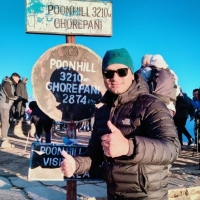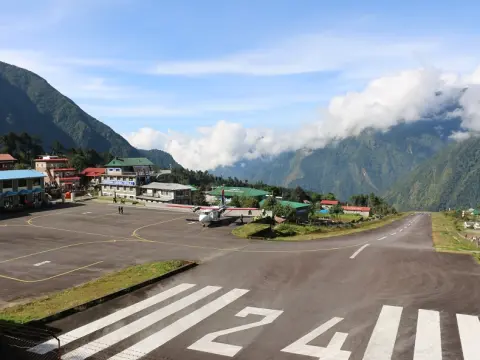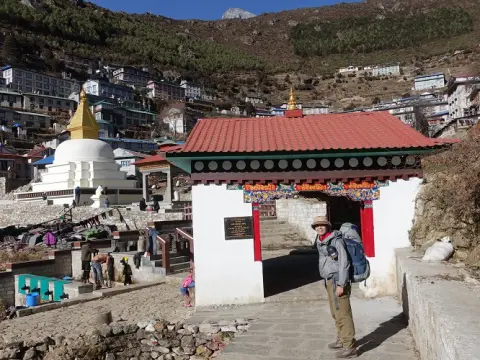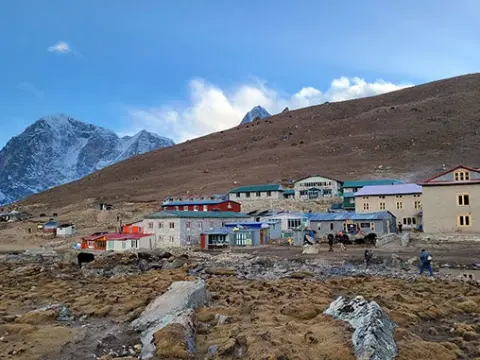Lukla: The Gateway Town to Everest Region
IntroductionLukla is a small but vital hill town in Nepal's Solukhumbu District of northeastern Nepal. At 2,860 meters (9,383 feet) elevation, it is t...


Actually, the Phakding village is home to Sherpa communities that have lived in the village for generations. The Sherpa culture, tradition, and hospitality, including their festivals, can be enjoyed by visitors. Phakding offers a peaceful atmosphere with beautiful natural scenery. The Dudh Koshi River nearby adds beauty to the village by offering a peaceful riverside atmosphere.
Likewise, Phakding is not only culturally and naturally important. It is strategically located on the trek route, and thus it is a compulsory stopover for trekkers. Climbers rest, eat, and recover from the first day of trekking in Phakding village. Teahouses and lodges within the village accommodate this requirement and offer meals and shelter.
Additionally, Phakding marks the beginning of trekking into the awe-inspiring Sagarmatha National Park, a World Heritage Site recognized by UNESCO. The trekkers start here and go on to Namche Bazaar and higher altitudes. The village itself and its facilities make it an ideal place to acclimatize and acclimate before moving on to higher altitudes.
Briefly, Phakding is an important and welcoming village on the Everest Base Camp trek. It offers cultural diversity, scenery, and pragmatic value to trekkers. Overall, Phakding is the perfect place to begin an unforgettable Himalayan adventure.
Phakding is situated in Nepal's Solu Khumbu district. Phakding is around 2,610 meters (8,563 feet) above sea level. Phakding is situated on the Dudh Koshi River, which is formed in the higher Himalayas and flows to the lower valleys. Because of this location, Phakding experiences a moderate mountain climate. The weather here varies from hot days to cold nights, especially in the spring and autumn trekking seasons.
Meanwhile, the village Phakding is surrounded by fir, rhododendron, and pine forests. These forests house various species of wildlife, like birds and small mammals. Apart from that, the landscape surrounding Phakding is also rough but picturesque. The hills around provide stunning vistas of the great mountains of the Everest range. Peaks like Thamserku (6,623 meters) and Kusum Kanguru (6,367 meters) blanket the sky in the horizon.
Likewise, Phakding lies in Sagarmatha National Park, a UNESCO World Heritage Site. The protected area holds parts of the high Himalayas and is famous for its unique biodiversity and spectacular views. As the village lies at the entry of the park, it serves as a gateway to explore the park trails and natural attractions.
Moreover, its proximity also makes the village a significant halt along the famous trekking trail to Everest Base Camp. From Phakding, the trekkers typically head north to Namche Bazaar, which is the principal Sherpa town in the area. The path goes along the Dudh Koshi River valley, crossing a number of suspension bridges along turbulent streams.
In summary, the geography and location of Phakding provide a mix of natural beauty, strategic location, and proximity to exposure to culture. In general, it serves as a perfect beginning to the Everest region for adventurers and travelers.
Phakding is accessed primarily by trekking from Lukla, the nearest airport village. As the gateway to the Everest region, most trekkers first arrive at Lukla by air. Phakding is thereafter usually reached after a brief 3- to 4-hour walk. The walk is considered relatively easy, thus Phakding is a typical first destination.
Meanwhile, Lukla is small but it is reachable from Kathmandu through regular flights. Flights, however, can be canceled or postponed due to weather conditions such as fog and strong winds. Trekkers therefore prefer to plan extra days in Lukla so that they do not miss their subsequent journey to Phakding.
Moreover, Lukla to Phakding trek route is through the valley of Dudh Koshi River. The route is clearly marked and well managed, with several suspension bridges over turbulent rivers. The trail also passes through beautiful rhododendron forests and typical Sherpa settlements. For this reason, the greatest majority of trekkers enjoy the views as well as cultural variation along the trail.
Likewise, other than trekking, there is no road access to Phakding. The Himalayan terrain is rugged and vehicle travel is limited, making foot travel the primary means of access. This helps in keeping the village's peaceful and natural atmosphere intact.
Briefly, access to Phakding mostly depends on trekking from Lukla. Flights from Lukla connect the Everest region to the rest of Nepal and the world. Given its proximity and easy trekking route, Phakding is a good initial stop. Generally, the accessibility of the village makes Phakding an extremely popular destination for Everest Base Camp trekkers.
Phakding offers basic but essential lodging for the Everest Base Camp trekkers. Being a stopover more after Lukla, the village itself focuses on providing comfortable lodging and dining. Simple rooms with beds, blankets, and common toilets are available in most teahouses and lodges. Apart from this, the lodges also offer basic Nepali food like dal bhat, noodles, and soups. Tourists can therefore rest and refuel to continue their trek.
Mainly, electricity in Phakding is available in the majority of lodges, but they can experience power outages, especially during the monsoon season. Similarly, there are some lodges with limited Wi-Fi or mobile network, though reception might be weak or discontinuous. Therefore, trekkers should carry power banks and expect limited internet connectivity. Further, charging devices in lodges is a normal practice but sometimes limited by power supply.
Moreover, Phakding contains small stores offering snacks, bottled water, and equipment like batteries, toilets, and clothing. The range is not as extensive as in larger towns like Namche Bazaar. Trekkers should thus prepare and carry important gear along.
But, medical centers are minimal in Phakding with only basic first aid being accessible in local health centers. In instances of grave medical conditions, one must travel to Namche Bazaar or Kathmandu. Proper insurance coverage and trekking permits with emergency centers are therefore highly recommended.
In summary, Phakding's facilities provide the basic needs of most trekkers. While basic, they provide essential support like food, shelter, and basic supplies. By and large, these facilities turn Phakding into a warm and handy starting point along the Everest Base Camp trek.
Phakding is a small village with plenty of sights to see despite its modest size. First of all, it is situated along the banks of the Dudh Koshi River, which provides pleasant river frontage vistas. Many trekkers enjoy walking along the riverbanks to relax and take pictures. Secondly, the fresh mountain air and peaceful surroundings make it an ideal location to relax after taking the Lukla flight.
Meanwhile, the village Phakding is surrounded by dense forests of fir, rhododendron, and pine. In springtime, the forests are made alive as rhododendrons flower red and pink. Similarly, bird observers also have the pleasure of the area as there are numerous species that inhabit the forest. Nature lovers therefore have the pleasure of scenic beauty and diversity surrounding Phakding.
Moreover, Phakding also has a Sherpa culture. There are local Sherpa families that live in the traditional houses and celebrate festivals with vibrant dances and rituals. Visitors are typically provided warm hospitality and have a chance to learn Sherpa traditions. In the same way, the small Buddhist monasteries in the village bring religious beauty to the landscape.
Also, the suspension bridges over the Dudh Koshi River are very fascinating in Phakding. These provide an adrenaline-fueled crossing experience and good views of churning water below. Moreover, the north trail beyond Phakding is a way to more gorgeous villages and mountain scenery and hence a gateway to more adventure.
In short, Phakding's largest tourist attractions are suspension bridge scenery, colored forests, Sherpa culture, and scenic riversides. Because of these, it remains one of the most favorite first points to visit for the Everest Base Camp trek. In general, Phakding offers a wide variety of natural and cultural experiences to visitors.
Phakding is a small village, but there are some fun activities for trekkers. Most of them arrive here after a brief trek from Lukla and stay overnight on their first evening in the region. Because of this reason, Phakding is a resting spot, acclimatization place, and a place to slowly discover. One of the typical activities is a river walk along the Dudh Koshi River. This peaceful walk provides the trekkers an opportunity to stretch themselves and enjoy the surroundings.
Similarly, and another popular activity is viewing the small monasteries and chortens that encompass the village. These are a reflection of the strong Buddhist heritage of the Sherpas. Also, the rotations of the prayer wheels and watching locals perform rituals add spiritual depth to the experience. Similarly, morning meditation or contemplation by some visitors are liked in these peaceful surroundings.
Moreover, another favorite activity in Phakding is photography. The village is rich with opportunities to photograph its surrounding hills, forests, and Sherpa villages. And yes, the early morning light condition for sunrise and sunset is simply perfect for landscape photography. Likewise, the suspension bridge, which is world-famous within the village, is a favorite shooting location for adventure seekers.
For culture enthusiasts, remaining in contact with Sherpa hosts and learning about their existence is highly recommended. You can ask questions, simply observe life pass by, or just share a warm tea together. Such cordial encounters usually prove to be some of the highlight moments on the trek.
Briefly speaking, Phakding offers a combination of easy walking, cultural tourism, spiritual tourism, and photography. Since it is the first overnight stop, the activities here are light but important. Overall, these experiences help the trekkers ease into Himalayan trekking and form early memories along the way.
Phakding is extremely popular among the hikers of Everest Base Camp. One of the reasons behind its popularity is the favorable location of Phakding. As it is just 3 to 4 hours from Lukla, Phakding is the perfect spot to start the trekking. The hikers arrive here to relax after the air journey and short trek. So, it plays an important role to help the travelers start the journey in a relaxed way.
Besides, the peaceful environment of the village on the Dudh Koshi River makes it very soothing. Phakding, as compared to the chaos of Lukla, offers a tranquil environment in the midst of nature. River walks, waving prayer flags, and the sound of thundering water are enjoyed by numerous travelers. Such gentle aspects play a huge role in Phakding's emotional appeal.
Similarly, the warmth of Sherpa hospitality does not render Phakding unmemorable. Lodge rooms here provide neat accommodation, warm service, and delectable food. In fact, Phakding's cozy teahouses make it to many travelers' journals of their travels. Because Sherpa culture is so deeply rooted, individuals get to feel intimate about native traditions.
Moreover, its status as an acclimatization stop is a second reason for the popularity of Phakding. Trekkers stay overnight here at 2,610 meters to allow their bodies to acclimatize slowly. This avoids climbing too high, too soon, which avoids altitude sickness. In the same way, the trail from Phakding to Namche Bazaar climbs steadily, so resting first is a sensible choice.
In short, Phakding is a favorite because it's situated strategically, with a peaceful ambiance, rich culture, and health benefits. It's not just a stopover—it's a warm welcome to the Khumbu region. Overall, Phakding is an integral part of every trekker's journey to Everest Base Camp.
Phakding has a range of teahouses and village lodges to accommodate the trekkers traveling to Everest Base Camp. Since it is the first overnight stop after Lukla, most trekkers avail themselves of this opportunity to stay here. The rooms in these lodges are clean, simple rooms with beds, blankets, and shared or private bathrooms. Some of the more upscale lodges also provide hot showers and attached bathrooms for extra luxury. Thus, travelers of all budgets can find a good place to sleep.
Meanwhile, the teahouses in Phakding also provide hot meals and snacks throughout the day. They all provide traditional Nepali food like dal bhat, noodles, fried rice, and momo dumplings. Likewise, hot drinks like milk tea, ginger lemon honey, and coffee are also served. As the food is cooked and served fresh and in warm dining halls, they become part of the evening experience.
Similarly, there are beautiful gardens or balconies in most of the teahouses at Phakding. The rooms offer a view of the Dudh Koshi River, surrounding forests, and distant hills. In fact, some travelers choose their lodge based on the view that it offers. In addition to this, there are also solar lights, charging points, and even Wi-Fi sometimes available, although the services are limited during bad weather.
Most of the teahouses in Phakding are run and owned by Sherpa families, known to be warm and hospitable people. The visitors tend to spend time having tea, stories, and jokes with the host family. This kind of cultural interaction enhances the experience. Moreover, through staying in local lodges, trekkers are directly involved in the local economy.
In summary, teahouses and lodges at Phakding have everything one needs for a comfortable stay. Because of their hospitality, services, and location, they become part of every trekker's experience. They provide more than rest, they offer a warm welcome to the Himalayas.


IntroductionLukla is a small but vital hill town in Nepal's Solukhumbu District of northeastern Nepal. At 2,860 meters (9,383 feet) elevation, it is t...

Introduction Namche Bazaar is a lively town in the Everest region. It is situated at 3,440 meters above sea level. The village is the main tradin...

IntroductionLobuche is a small village in Nepal's famous Khumbu region. It stands at the lofty altitude of 4,910 meters (16,100 feet) above sea level....
